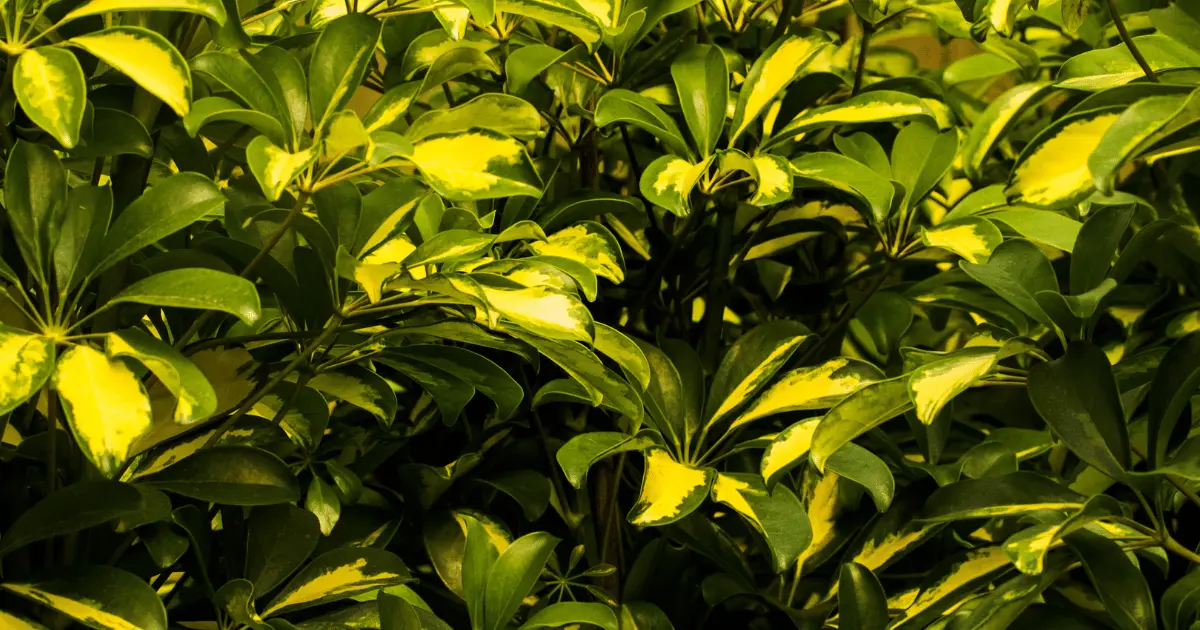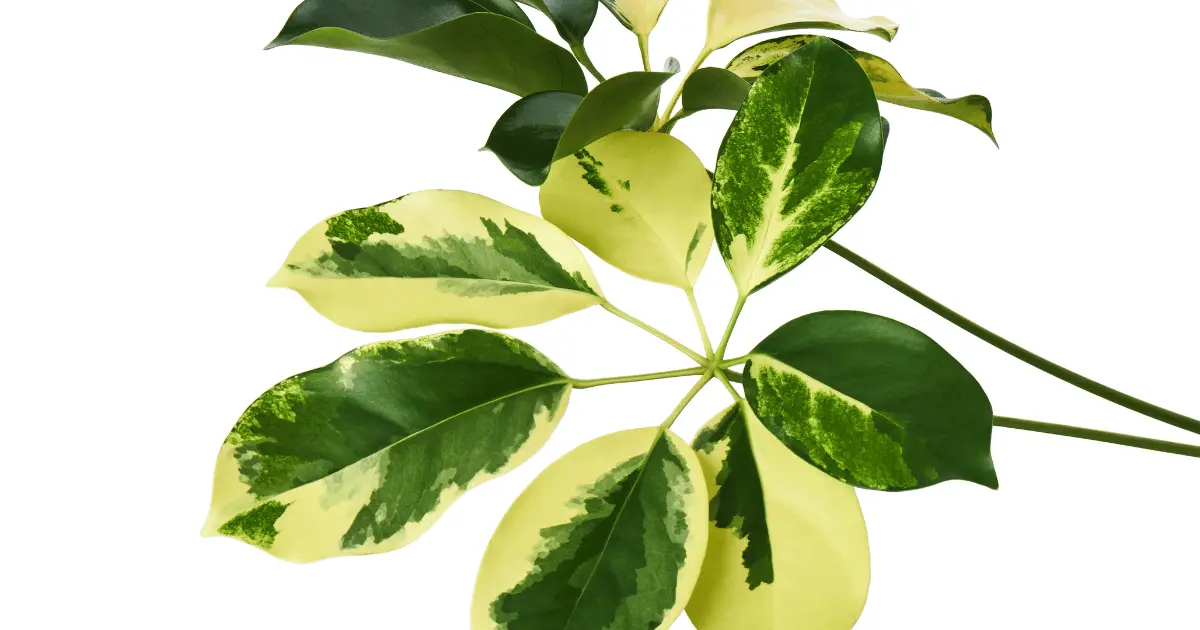Variegated Schefflera is a tropical evergreen tree native to Queensland, Australia. The tree grows up to 20 feet tall and has large, glossy leaves variegated with white and green. During the summer, the tree blooms with small, white flowers.
Schefflera plants have a wide range of uses. They are popular landscape shade trees, and many restaurants and homes use them as ornamentals worldwide. They are known for their fast growth rate, hardiness, evergreen foliage, and beautiful leaves.
This guide will cover all you need to know about this lovely plant, including tips on growing it, caring for it, and which issues to watch out for.
What is a Variegated Schefflera?

Variegated Schefflera, also known as Schefflera actinophylla, is a stunning plant with many names. It is a slower-growing tropical forest epiphyte that grows by clinging to trees in its native habitat. In the United States, it is frequently found growing on banyan trees, mimicking their sprawling white roots. When grown indoors, however, it needs to be hung from a sturdy wire that can support its weight and give it room to grow upward.
Schefflera plants grow quickly, particularly when planted outside, where they may reach 3 feet per year. It is best to plant Schefflera in warm-climate gardens in the spring or autumn when the temperatures aren’t too high. It’s important to remember that the Schefflera plant is somewhat harmful to humans and extremely toxic to cats, dogs, and horses.
Types of Schefflera Varieties
The Schefflera plant has two main varieties: the Dwarf Schefflera and the Giant Schefflera. The Dwarf Schefflera only grows to about 3 feet tall and has smaller leaves than the Giant Schefflera. Both varieties are easy to care for and make great houseplants. If you want to cultivate a plant that can purify the air and has attractive foliage, the Schefflera plant is what you need.
Here are other Schefflera varieties to have in your home or garden.
1. Schefflera actinophylla (Australian umbrella tree)

This Schefflera variety resembles miniature umbrella trees. It can reach heights of up to 2 meters tall indoors and 10 to 15 meters tall outdoors. It is also known as the octopus tree or the Queensland umbrella tree.
2. Schefflera arboricola (Dwarf umbrella tree)

This species of Schefflera is popular as a houseplant and comes in various colors. It is resilient, simple to care for, and grows to a height of 30 to 200 cm.
3. Schefflera alpina (Alpina)

The Alpina is a wild Schefflera variety that is more tolerant to chilly temperatures than conventional varieties. It can grow to a height of 5-6 feet indoors.
4. Schefflera ‘Trinette’
This Schefflera variety is well-known for its striking hue. This plant will make you thrilled if you desire a variegated type that stands out with its green leaves covered with creamy yellow areas. Keep it in a light location for the best colors.
5. Schefflera ‘Gold Capella‘

This cultivar has palm-like, glossy leaves that are a wonderful mix of golden yellow and green. It is a fast-growing species that you can keep under control with frequent pruning.
6. Schefflera ‘Madame De Smet’
This Schefflera cultivar is well-known for its unusual name, and it’s a stunning cultivar with dark green leaves that are heavily variegated in golden white. Furthermore, this wonderful houseplant has a compact design suitable for indoors and in gardens.
7. Schefflera elegantissima
This variety has tall and thin stems with attractive serrated leaves that are copper-burgundy and deep green when mature.
8. Schefflera taiwaniana (Taiwanese Schefflera)
This Schefflera variety has glossy, black leaves resembling a wheel’s spokes, and it looks particularly lovely with the red stalks. It also has fine silver hair that adorns the foliage as well.
Propagating Variegated Schefflera
Cultivating variegated Schefflera is best done in the spring to prevent your existing plant from becoming overly bushy while providing you with new plants. You can propagate variegated Schefflera through stem cuttings. Here’s how to go about it:
- Cut a six-inch portion of the stem at a 45-degree angle using sharp, sterilized pruning shears, and clip all but 4 or 5 leaves from the top of the stem.
- Soak the cut end in rooting hormone before placing it in a container or pot filled with potting mix or growth medium.
- Wrap the pot with a loosely closed plastic bag to preserve moisture within the plant, and then set it in a spot with bright indirect light.
- Inspect the container daily to ensure the soil is moist and water it as needed. Gently pull on the stem to check for root development.
- If roots have emerged after approximately a month, discard the plastic bag and continue developing the new plant. If no roots develop, remove the cutting and try again with a fresh cutting.
Potting and Repotting Variegated Schefflera
Repotting variegated Schefflera can be done yearly or as required, such as when they need a larger pot, fresh soil, or have grown too large for their pots. Extending the time between repotting and letting them become slightly root-bound will help slow the growth rate and prevent the plants from becoming too large.
If you decide to repot your variegated Schefflera, take it from its pot or container and carefully release the roots; soaking them in water can help with this process. To repot, use a bigger pot or container with drainage holes (plastic or clay) and fill it with well-drained soil mix (part peat moss and perlite).
Caring for Variegated Schefflera
When caring for your variegated Schefflera, there are a few things to remember. Here are some tips on how to care for your variegated Schefflera:
Light
Variegated Schefflera prefers bright, indirect light but can tolerate low light conditions. So, if you’re growing it indoors, be sure to place it near a window where it will get plenty of light without being in direct sunlight. Move your potted Schefflera plant outdoors in the summer, where it’ll get brighter light and not direct sunlight, such as underneath a patio cover. Avoid planting your Schefflera in full sun since the intense heat can scorch the leaves.
Water
Secondly, water your Schefflera when the top inch or so of soil is dry. Allow the water to drain before putting the pot back on its saucer. During the growth season, water or mist the leaves frequently and wait until the soil in the container dries up before thoroughly soaking it. Lower your watering frequency during the cold months, as overwatering can cause yellow and falling leaves or kill your Schefflera plant.
Soil
Plant your variegated Schefflera in rich, porous, well-drained potting soil if you’re cultivating it indoors. A sandy, well-draining loam soil with a moderately acidic pH is suitable for outdoor cultivation. Avoid planting in an outdoor setting where the soil gets saturated or excessively damp. To encourage bushy growth, pinch back new growth regularly, which will also help keep your plant from becoming leggy.
Humidity and Temperature
Variegated Schefflera prefers reasonably high tropical and humid temperatures since it is a tropical plant; temperatures below 60 degrees Fahrenheit will cause it to decline. Avoid exposing these plants to drafts or dry heating vents. The leaves of an underwatered or frosty Schefflera will drop fast, so treat leaf-drop seriously and rectify the problem if it happens. If the plant sheds all of its leaves, you can save it by moving it outside in the spring and watering it generously.
Fertilizer
Lastly, fertilize your tree every other month during the growing season with a balanced fertilizer. During the growth season, fertilize your variegated Schefflera twice a week with liquid houseplant fertilizer or two sprays of slow-release pellets. This procedure is crucial since Schefflera plants are big feeders and will thrive from the additional nutrients. Cut back on fertilizing in the winter when growth slows down.
Pruning
Your variegated Schefflera may need pruning occasionally, particularly if it is not receiving enough light. Remove any excessive foliage or leggy plant sections. Schefflera plants recover rapidly after trimming and will reward you with a fuller, bushier plant.
Pests and Diseases of Variegated Schefflera
Pests and diseases are uncommon in variegated Schefflera but can occasionally occur. Common pests include mealybugs, aphids, whiteflies, and spider mites. You can control pest infestation with regular applications of insecticidal soap or neem oil.
Diseases are even less common but can include leaf spots and root rot. Other problems you might encounter when cultivating variegated Schefflera are yellowing leaves and brown spots on the foliage. Overwatering can cause the leaves on your variegated Schefflera to turn yellow, while underwatering can cause brown spots on the leaves.
You can also control the spread of fungal diseases by ensuring the plant has good drainage and is not overwatered. Alternatively, you can water your plant thoroughly; allow the soil to dry before watering it again.
Variegated Schefflera is a beautiful, low-maintenance houseplant; and a great option for beginner gardeners. With its glossy leaves and striking variegation, it’s sure to add a touch of elegance to any room. And, with proper care, it can thrive indoors for many years. So, the variegated Schefflera is worth considering if you’re looking for a plant that will make a big impact without requiring much work.
